srImathE rAmAnujAya nama:
srImadh varavaramunayE nama:
srI vAnAchala mahAmunayE nama:
gOpAlakrishNa dhAsar (kOnAr) who was living in chennai and a sishya of
kOil kandhAdai vAdhUla aNNan swamy compiled a set of beautiful
phrases/sentences from nampiLLai‘s eedu (documented by vadakku thiruvIdhi piLLai) vyAkyAnam long ago. kOil vidhwAn srI U. vE. R
narasimhAchAryar swamy (paramapadhavAsi) wrote simple thamizh meanings
for those phrases/sentences. This book (https://docs.google.com/file/d/0ByVemcKfGLucbWJNTUMzVS1KTzA/edit?usp=sharing) was originally released on 7-1-68 and
was re-published by puthur raghurAman swamy (editior: srI sailEsa
dhayApAthram magazine). In this series we are relishing this great compilation with the english translation for the same.
161. praNavArththamum namachchabdhArththamum vyApakathvamum avyApakthvamum allAtha vyApaka manthirangaLilum uNdu.
ப்ரணவார்த்தமும் நமச்சப்தார்த்தமும் வ்யாபகத்வமும் அவ்யாபக்த்வமும் அல்லாத வ்யாபக மந்திரங்களிலும் உண்டு.
“Om” means jIvAthmA is a servitor of bhagavAn. “nama:” means “I am not a servitor for myself”. These and bhagavAn’s omnipresence is explained in other vyApaka manthrams as well.
Translator’s note: manthram is usually made of 3 parts – praNavam, nama: and bhagavAn‘s thirunAmam. Here the importance of thirumanthram (ashtAkshari) is highlighted. Let us enjoy this with the shining light of piLLai lOkAchAryar‘s mumukshuppadi with mAmunigaL‘s divine commentary where this principle is clearly explained.
- sUthram 8 – bhagavan manthrangaL thAn anEkangaL (பகவந் மந்த்ரங்கள் தான் அநேகங்கள்) – Just like there are innumerable auspicious qualities for bhagavAn and he reveals those qualities in innumerable incarnations, the manthrams which focus on such divine auspicious qualities/forms are also innumerable.
- sUthram 9 – avaithAn vyApakangaL enRum avyApakangaL enRum iraNdu vargam (அவைதான் வ்யாபகங்கள் என்றும் அவ்யாபகங்கள் என்றும் இரண்டு வர்க்கம்) – Those manthrams are of two types:
-
- vyApaka manthram – manthram which focusses on bhagavAn‘s true nature and his omnipresence.
-
- avyApaka mantharm – manthram which focusses on a particular avathAram (incarnation) or guNam (quality)
- sUthram 10 – avyApakangaLil vyApakangaL mUnRum srEshtangaL (அவ்யாபகங்களில் வ்யாபகங்கள் மூன்றும் ச்ரேஷ்டங்கள்) – vyApaka manthrams carry more importance over avyApaka manthrams. As vishNu gAyathri highlights nArAyaNa, vAsudhEva and vishNu manthrams – these 3 manthrams take precedence over all other manthrams. All these 3 manthrams reveal bahgavAn’s omnipresence.
- sUthram 11 – ivai mUnRilum vaiththukkoNdu periya thirumanthram pradhAnam (இவை மூன்றிலும் வைத்துக்கொண்டு பெரிய திருமந்த்ரம் ப்ரதாநம்) – Of these 3 vyApaka manthrams – nArAyaNa manthram (ashtAkshari) is the most important due to the following reasons:
-
- as it is recited first in the vishNu gAyathri
-
- it fully reveals bhagavAn‘s omnipresence in the most precise way.
-
- since sAsthram declares that there is no manthram higher than ashtAksharam.
- sUthram 12 – maRRavai iraNdukkum achishta parigrahamum apUrththiyum uNdu (மற்றவை இரண்டுக்கும் அசிஷ்ட பரிக்ரஹமும் அபூர்த்தியும் உண்டு) – Here nArAyaNa manthrams greatness and vAsudhEva/vishNu manthrams limitations are revealed.
-
- “nArAyaNa” shabdham (word) reveals bhagavAn‘s svarUpam (true nature), rUpam (forms), guNams (auspicious qualities), etc. The other two manthrams primarily focus on svarUpam (vyApthi – omnipresence) only.
-
- the other two manthrams are also used by kudhrushtis (the ones who misinterpret vEdhas) and are often misinterpreted.
162. nammAchAryargaL pOnathu pOthumiRE namakkAdharikka vENduvathu.
நம்மாசார்யர்கள் போனது போதுமிறே நமக்காதரிக்க வேண்டுவது.
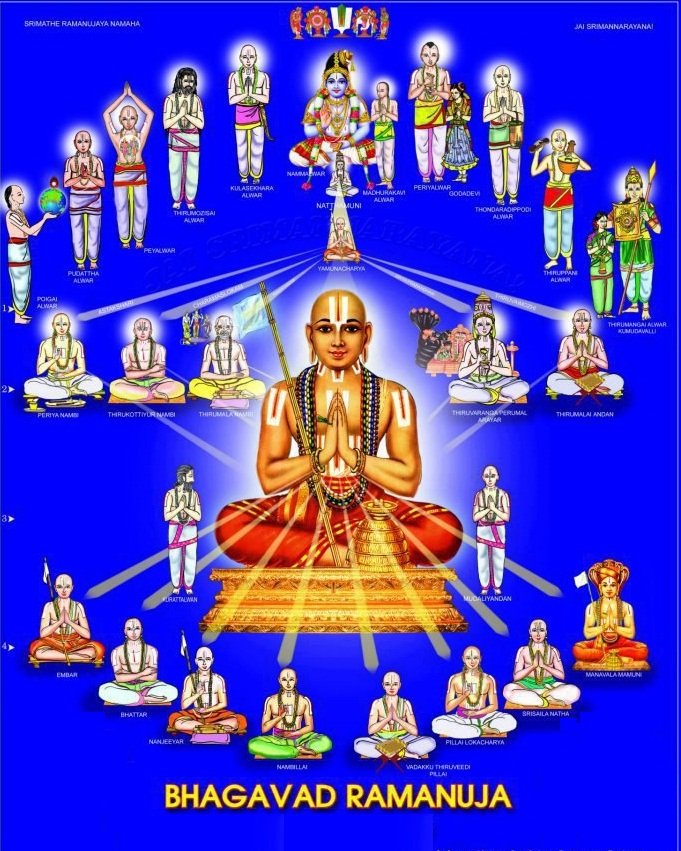
We have to pursue the path taken by our AchAryas. That is sufficient.
Translator’s note: This can be understood in two different contexts.
- General context – Our pUrvAchAryas are fully blessed by emperumAn and are fully realized in the essential principles. They have clearly laid out the guidelines for us to follow. They have also practically demonstrated how to conduct ourselves in various situations. All of these are documented in detail in many of our pUrvAchArya granthams and they are there for us to study and follow them. To have a glimpse of our pUrvAchAryas‘s life style, please visit https://granthams.koyil.org/anthimopaya-nishtai-english/, https://granthams.koyil.org/srivaishnava-lakshanam-english/, etc.
- thirumanthram context (in continuation of 161st entry) – After highlighting the glories of thirumanthram, piLLai lOkAchAryar highlights in sUthram 13, “vEdhams, rishis, AzhwArs and AchAryas had great affiliation towards thirumanthram” and due to that reason it has a special status over other manthrams. And since our AchAryas had great attachment towards thirumanthram – we also are/should be fully focussed on the same. mAmunigaL gives an elaborate commentary for this sUthram quoting several pramANams. Even thirumanthram, our AchAryas focus on the meanings (arththam) of thirumanthram more than mere recital (japam). In the vyAkyaAnam for thiruvAimozhi 1.2.10 – “eN perukkan nalaththu oNporuLIRila vaN pugazh nAraNan thiN kazhal sErE” (எண் பெருக்கந் நலத்து ஒண்பொருளீறில வண் புகழ் நாரணன் திண் கழல் சேரே) – nampiLLai beautifully highlights that “While others use thirumanthram in japam/hOmam, etc, our AchAryas only focussed on the essential principle that is revealed through thirumanthram and that is befitting for the true nature of the jIvAthmA, i.e., that the jIvAthmA is the servitor of bhagavAn and his existence is to serve bhagavAn only”.
163. avanaip peRavENumenRiruppAr Achaippaduvathum avaL munnAgavAy, peRRapin kainkaryam paNNumathumiruvarumAna chErththiyilEyAyirukkumiRE.
அவனைப் பெறவேணுமென்றிருப்பார் ஆசைப்படுவதும் அவள் முன்னாகவாய், பெற்றபின் கைங்கர்யம் பண்ணுமதுமிருவருமான சேர்த்தியிலேயாயிருக்குமிறே.
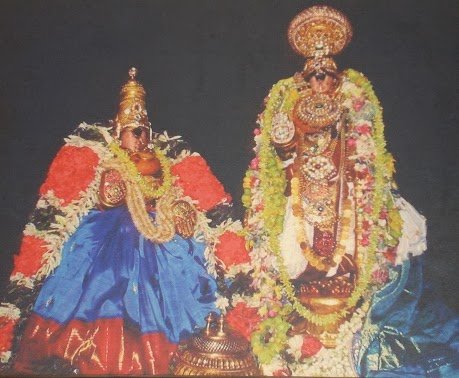
Ones who desire to reach bhagavAn, they approach him through pirAtti. Once they reach bhagavAn, they serve the divine couple together. This is well-estbalished.
Translator’s note: dhvaya mahA manthram is an expansion of thirumanthram. Our pUrvAchAryas fully focussed on dhvaya mahA manthram since it clearly and explicitly reveals the relationship between bhagavAn and pirAtti and our attitude towards them. dhvaya mahA manthram has two parts.
- In the first part, we approach bhagavAn through srI mahAlakshmi who is inseparable from bhagavAn and is always performing purushakAram (recommendation) to bhagavAn on behalf of us. Through here recommendation we surrender unto the lotus feet of bhagavAn and accept that he is our only refuge.
- In the second part, we pray for eternal kainkaryam for the pleasure of the divine couple with no tinge of desire for self-enjoyment.
There are several instances where AzhwArs demonstrated this principle:
- When perumAL (srI rAma) decided to go to the forest, iLaya perumAL (lakshmaNan) surrendered to srI rAma with the purushakAram of sIthA pirAtti. When they were in the forest, he revealed that he wants to fully serve there for the pleasure of the divine couple only.
- nammAzhwAr fully reveals the first part of dhvaya mahA manthram in thiruvAimozhi 6.10.10 – agalagillEn (அகலகில்லேன்) pAsuram.
- nammAzhwAr highlights the divine meanings of dhvaya mahA manthram in thiruvAimozhi 10.10.7 – kOlamalarppAvaikku anbhAgiya en anbhEyO (கோலமலர்ப்பாவைக்கு அன்பாகிய என் அன்பேயோ) – Because emperumAn has great attachment towards pirAtti, he has great attachment towards me (who approached bhagavAn through her purushakAram) too.
- thirumangai AzhwAr (in mother’s mood) highlights in periya thirumozhi 2.7.1 “thivaLum” (திவளும்) that parakAla nAyaki approaches thiruvidaventhai emperumAn knowing well that srI mahAlakshmi is always with him and she will recommend to emperumAn to accept parakAla nAyaki.
164. svarUpam bhagavath pArathanthriyam enRaRinthAl chIriya prayOjanam kainkaryamiRE.
ஸ்வரூபம் பகவத் பாரதந்த்ரியம் என்றறிந்தால் சீரிய ப்ரயோஜநம் கைங்கர்யமிறே.
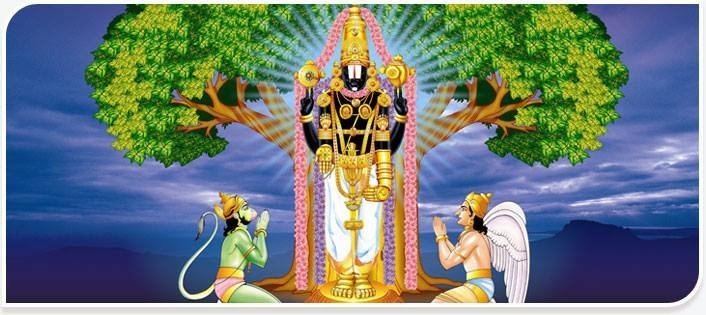
Once it is understood that “My nature is to be at full disposal of bhagavAn“, the resulting effect is to serve bhagavAn. This is well-estbalished.
Translator’s note: pArathanthriyam means “devoid of any independence”. kainkaryam means service. jIvAthmA is naturally and full dependant on bhagavAn in all states. Everything – sentient and insentient – exist purely for the pleasure of bhagavAn. Let us see a couple of incidents from periyavAchAn piLLai‘s life in this connection.
- vArthA mAlai 14 – When some srIvaishNavas ask him “Are we the target of bhagavAn’s leelai (pastimes) or irakkam (krupai – mercy)?”, periyavAchAn piLLai replies “if we are happily engaged in samsAram (materialistic activities, sensual pleasures, etc) we become target of his leelai; if we feel that we are caught in this dangerous ocean of samsAram and are eager to be relieved from the miseries, we become target of his mercy” – either way we are dependent on him and target of his enjoyment. Our pUrvAchAryas have highlighted that it is better to realize one’s true nature as a servant of bhagavAn and serve him properly.
- vArthA mAlai 48 – A srIvaishNava asks periyavAchAn piLLai “what is the nature of pArathanthriyam?”. He replies “Taking refuge of bhagavAn (omnipotent) after fully giving ones own abilities, without having a tinge of svAthanthriyam in upAyam (I have done something to get bhagavAn’s mercy – should not be present at all) and having great attachment towards kainkaryam to bhagavAn”.
165. rAmAvathAraththil meyyum krshNAvathAraththil poyyumiRE Asritharkkuth thanjam.
ராமாவதாரத்தில் மெய்யும் க்ருஷ்ணாவதாரத்தில் பொய்யுமிறே ஆச்ரிதர்க்குத் தஞ்சம்.
For the ones who are surrendered to bhagavAn, truth spoken by srI rAma and lies spoken by krishNa are the refuge.
Translator’s note:

In rAmAvathAram, emperumAn always spoke the truth. emperumAnAr highlights in his sharaNAgathi gadhyam quoting periya perumAL himself saying “rAmO dhvir nA bhibhAshathE” (ராமோ த்விர் நா பிபாஷதே) – “In my rAmAvathAram if I committed once, I never go back in those words” and highlights the rAma charama slOkam, where srI rAma himself declares that “if one surrenders to me even once, I will protect him – this is my vow”. So, the devotees of emperumAn fully depend on srI rAma’s truthful and caring words.
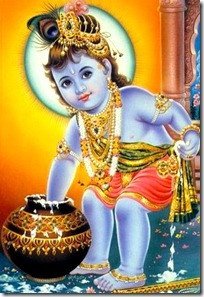
In krishNAvathAram, emperumAn spoke many lies – but his lies are most relishable for the devotees. His divine activities, even though may look contrary to sAsthram at times, are still relishable by his devotees since its done by him. Let us see this from various pramANams.
- kaNNan emperumAn himself highlights this in gIthA 4.9 “janma karma cha mE dhivyam Evam yO vEththi thathvatha: thyakthvA dhEham punar janma naithi mAm Ethi sOrjuna” (ஜந்ம கர்ம ச மே திவ்யம் ஏவம் யோ வேத்தி தத்வத: த்யக்த்வா தேஹம் புநர் ஜந்ம நைதி மாம் ஏதி ஸோர்ஜுன) – Oh arjuna! One who truly understands my divine birth and divine activities, once they give up their body in this life, they will never be born again in this samsAram.
- ANdAL nAchiyAr beautifully glorifies in nAchiyAr thirumozhi 14.3 “mAlAyp piRantha nambiyai mAlE seyyum maNALanai ElAp poygaL uraippAnai ingE pOthak kaNdOmE” (மாலாய்ப் பிறந்த நம்பியை மாலே செய்யும் மணாளனை ஏலாப் பொய்கள் உரைப்பானை இங்கே போதக் கண்டோமே) – bhagavAn who is filled with auspicious qualities, appears here in a form that is just made of love towards the gOpikAs, he shows his love and nurtures their love towards him and he speaks beautiful lies whenever required. periyavAchAn piLLai highlights beautifully that his lies are the means for the gOpikAs to achieve him and they are good for the jIvAthmAs. He also quotes this exact entry (165) in this pAsura vyAkyAnam.
- nammAzhwAr highlights in 5.3.5 “kadiyan kodiyan nediyamAl … en nenjam avan enRE kidakkum ellE” (கடியன் கொடியன் நெடியமால் … என் நெஞ்சம் அவன் என்றே கிடக்கும் எல்லே) – Even though kaNNan emperumAn may be hard-hearted, cruel, etc, my heart will still long for him only, because that is my nature. Even if there are some faults in bhagavAn, that is relishable by me.
- kUrathAzhwAn, in his athimAnushasthavam, highlights the same principles beautifully. In slOkams 34 to 58, he explains the glories of krishNAvathAram. He says that whenever we see faults in a normal person that leads to aversion towards that person. But, when we see faults in bhagavAn that brings us closer to him due to them being most divine. For example, stealing is a fault in normal cases and the person who steals is generally condemned. But when bhagavAn steals butter every one becomes so attached towards him seeing his saulabhyam (simplicity) in behaving like a normal child.
உகந்தாரை அழிக்கையிறே பாதகமாவது; விரோதிகளை அழிக்குமது உபகாரமிறே.
If bhagavAn destroys the ones who have great desire towards him – that is unfavourable. But to destroy the enemies of the ones who have great desire towards him is favourable. This is well-estbalished.
Translator’s note: AzhwArs feel unbearable sorrow when in separation from emperumAn and in such cases they simply feel totally helpless and broken. They cannot sustain even for a moment from bhagavAn. In those times they question emperumAn‘s intent in making them suffer so much and destroying them. On the other hand, if bhagavAn destorys the hurdles in reaching emperumAn for such devotees, that is most desirable and favourable too. The primary hurdles/enemies for one to reach emperumAn is the vicious cycle of samsAram and the devotees are most happy when their connection to samsAram is destroyed and they reach paramapadham to perform eternal service to emperumAn.
167. brahmahathyaikku prAyaschiththam paNNinAl gOhathyaikku prAyaschiththam paNNavENdivarumiRE. angan vENdAviRE bhagavathanugraham koNdu kAryam koLLumidaththil.
ப்ரஹ்மஹத்யைக்கு ப்ராயச்சித்தம் பண்ணினால் கோஹத்யைக்கு ப்ராயச்சித்தம் பண்ணவேண்டிவருமிறே. அங்ஙன் வேண்டாவிறே பகவதநுக்ரஹம் கொண்டு கார்யம் கொள்ளுமிடத்தில்.
After killing a brAhmaNa, a person realizes his mistake and atones to eradicate the sin acquired by such killing. Subsequently. If he kills a cow, he has to atone for that separately to eradicate the sin acquired by such killing. The previous atonement will not help. But when emperumAn blesses a jIvAthmA and the jIvAthmA fully surrenders to emperumAn, that will be capable of eradicating all sins.
Translator’s note: This is highlighted in eedu vyAkyAnam for thiruvAimozhi 9.8.1 “aRukkum vinai” (அறுக்கும் வினை) pAsuram. In this pAsuram, nammAzhwAr highlights that “For the ones who have firmly placed bhagavAn in their heart, all their pApams (and puNyams) will be destroyed”. In the vyAkyAnam, nampiLLai highlights kaNNan emperumAn’s charama slOkam “sarva pAbhEpyO mOkshayishyAmi” (ஸர்வ பாபேப்யோ மோக்ஷயிஷ்யாமி) – where he says “All sins will be removed”. nampiLLai explains that when we try to remove our sins on our own efforts, we have to do one by one but when bhagavAn blesses us, all the sins will be removed at once. piLLai lOkAchAryar highlights the importance of the word “mOkshayishyAmi” in mumukshuppadi sUthram 255. The “ishyAmi” indicates bhagavAn saying “I dont have to make any efforts and you dont have to make any efforts; the sins will themselves run away from you seeing that you have taken shelter of me”.
ANdAL nAchiyAr highlights by constantly glorifying bhagavAn and constantly meditating on him, sins from the past and the future will vanish in thiruppAvai 5th pAsuram “pOya pizhaiyum pugu tharuvAn ninRanavum thIyinil thUsAgum” (போய பிழையும் புகு தருவான் நின்றனவும் தீயினில் தூசாகும்).
piLLai lOkAchAryar highlights that surrendering to emperumAn will eradicate all blemishes at once in sUthram 146. In the vyAkyAnam, mAmunigaL highlights “sarva pAbEpyO mOkshayishyAmi” and emperumAnAr‘s prayer in sharaNAgathi gadhyam to eradicate all sins after performing prapathi.
168. AsritharakshaNaththukkum thathprathikUla nirasanaththukkumadi sriya:pathiyAgai.
ஆச்ரிதரக்ஷணத்துக்கும் தத்ப்ரதிகூல நிரஸநத்துக்குமடி ச்ரிய:பதியாகை.
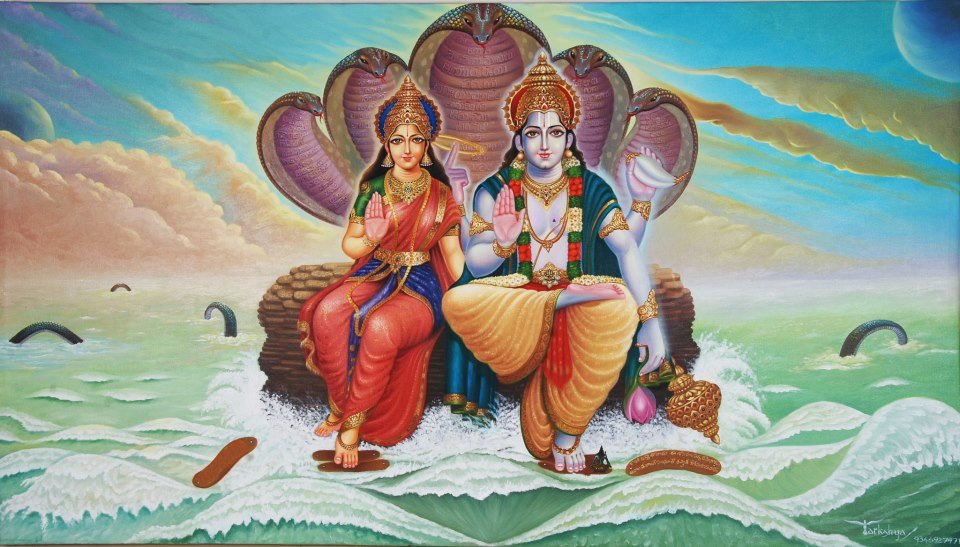
Because bhagavAn is the divine consort of srImahAlakshmi, he protects his devotees and he annihilates the enemies of such devotees.
Translator’s note: bhagavAn qualities are of two types:
- svarUpa nirUpaka dharma – the essential attributes that identify bhagavAn without which he is inconceivable. This includes sathyam gyAnam anantham (eternal, filled with knowledge, unlimited), ubhaya vibhUthi nAthathvam (the master of both spiritual and material worlds), srIya:pathithvam (being the divine consort of srI mahAlakshmi), sarva kAraNathvam (being the cause of all causes), anantha sAyithvam (lying on the serpent bed), puNdarikAkshathvam (having lotus eyes), garuda vAhanathvam (having garudAzhwAr as vAhanam), etc. Of these, sriya:pathithvam is the most important quality – thirumazhisai AzhwAr declares “thiruvillAth thEvaraith thEREnmin thEvu” (திருவில்லாத் தேவரைத் தேறேன்மின் தேவு) – the ones who are not connected to srI mahAlakshmi – I will not consider them as God.
- nirUpitha svarUpa visEshaNa – the additional attributes of the established entity – such as saulabhyam (simplicity – easy accessibility), sauseelyam (magnanimity), vAthsalyam (motherly forbearance), etc.
- sUthram 40 – Since pirAtti is required to be present when bhagavAn protects, srI mahAlakshmi‘s presence is implied. mAmunigaL beautifully highlights “lakshmyA saha hrushIkEsO dhEvyA kAruNya rUpayA; rakshakas sarvasidhdhAnthE vEdhAnthEpi cha gIyathE” (லக்ஷ்ம்யா ஸஹ ஹ்ருஷீகேசோ தேவ்யா காருண்ய ரூபயா; ரக்ஷகஸ் ஸர்வஸித்தாந்தே வேதாந்தேபி ச கீயதே) – As pirAtti (who is filled with mercy) nurtures and brings bhagavAn’s mercy to the forefront, her presence is always required to subdue bhagavAn’s svAthanthriyam, forgive the jIvAthmA‘s sins and accept him.
- sUthram 41 – bhagavath sEnapAthi misrar says “If she leaves his divine chest, she will not be seen in akAram as well” – Aptha vachanam (trustworthy source). piLLai lOkAchAryar quotes bhagavath sEnApathi misrar, who explains that pirAtti never leaves bhagavAn’s chest as seen in thiruvAimozhi 6.10.10 “agalagillEn iRaiyum” (அகலகில்லேன் இறையும்) – pirAtti saying “I will not leave even for a moment”. Similarly, in akAram, even though pirAtti is not identified explicitly, it is to be understood that pirAtti is present there.
169. brAhmaNarkku sandhyAvandhanam pOlE idaiyargaLukku pasu mEykkai. jAthyuchitha dharmamAgaiyAlE thavira oNNAdhirukkumiRE.
ப்ராஹ்மணர்க்கு ஸந்த்யாவந்தனம் போலே இடையர்களுக்கு பசு மேய்க்கை. ஜாத்யுசித தர்மமாகையாலே தவிர ஒண்ணாதிருக்குமிறே.
Tending cows for gOpas (cow-herd men) is like performing sandhyAvandhanam for brAhmaNas. As it is a mandatory requirement per ones own varNa dharmam it cannot be skipped. This is well-estbalished.
Translator’s note: varNAsrama dharmam is of paramount importance for srIvaishNavas. As devotees of srIman nArAyaNa, one must satisfy the orders of bhagavAn. bhagavAn himself says:
sruthi: smruthi: mamaiva AgyA
yasthAm ullangya varththathE
AgyAchchEdhi mama dhrOhi
madh bhakthOpi na vaishNava:
ஸ்ருதி: ஸ்ம்ருதி: மமைவ ஆக்யா
யஸ்தாம் உல்லங்ய வர்த்ததே
ஆக்யாச்சேதி மம த்ரோஹி
மத் பக்தோபி ந வைஷ்ணவ:
Simple translation: sruthi (vEdhams) and smruthi (dharma sAsthrams, etc) are my orders and they have to be followed. The ones who dont follow them are called traitors, even if they are my devotees they wont be called as vaishNavas.
Whatever may be the case, nithya karma anushtAnams have to be performed.
There are some important aspects for srIvaishNavas is this principle:
- karmAnushtAnams are of 3 types:
- nithya karmA – daily activities such as sandhyAvandhanam, samithA dhAnam (for brahmachAris), aupAsanam (for gruhasthas), etc.
- naimiththika karmA – periodic/specific activities such as pithru tharppaNam, etc.
- kAmya karmA – activities which are done to obtain material benefits such as jyOthishtOmam (to go to svargam), etc.
- Any nithya karmA or naimithika karmA must be done as kainkaryam to emperumAn. They are not done with the desire to achieve anything in return.
- srIvaishNavas generally dont indulge in kAmya karmAs.
- When there is bhagavath/bhAgavatha/AchArya kainkaryam they take precedence over karmAnushtAnam. Once, when bhattar was with namperumAL doing thiruvAlavatta kainkaryam, in the evening time, one of the srIvaishNavas remind him to perform sandhyAvandhanam. bhattar replies that “there is nothing wrong in not performing sandhyAvandhanam at this junction when being involved in bhagavath kainkaryam”. But once our kainkaryam is complete we can always get back to karmAnushtAnams.
- nAyanAr
says in AchArya hrudhayam (31) “aththANich chEvakaththil podhuvAnathu
nazhuvum” (அத்தாணிச் சேவகத்தில் பொதுவானது நழுவும்) – When a srivaishnava engages in kainkaryam, he will be
naturally relieved from sAmAnya dharmam like sandhyAvandhanam, agni
kAryam,etc. - mAmunigaL‘s
vyAkyAnam is beautiful and most precise here – he says as the natural
position of jIvAthmA is to serve emperumAn directly – kainkaryam takes
precedence over everything else. sAmAnya dharmam which is per varNam and
Asramam is indirect kainkaryam to emperumAn as we understand all
dhEvathas have emperumAn as antharyAmi and sruthi/emperumAn directs us
to perform these karmAnushtAnams. But
when there is “kainkaryam”, others take the backseat. mAmunigaL further
explains – though they take the back seat – why is our pUrvAchAryas seen
engaging in sAmAnya dharmam? Basically “Why should we do it?” is the
question. He beautifully explains that our pUrvAchAryas did it out of
overwhelming mercy – if srivaishnavas who are staunch followers of bhagavAn himself dont follow karmAnushtAnam which is instructed by
bhagavAn himself – others will follow the same and give up their
karmAnushtAnam and be fallen – so our pUrvAchAryas performed sAmAnya
dharmam (whenever there is no contradiction or interference with visEsha
dharmam).
Similar principle is explained in siriya thirumadal “vArAr vanamulaiyAL maththArap paRRikkoNdu” (வாரார் வனமுலையாள் மத்தாரப் பற்றிக்கொண்டு) – here periyavAchAn piLLai questions why should yasOdhA herself churn the curd to get butter instead of getting her many assistants to do it for her. He himself beautifully explains that it is both varNa (vaisya) and Asrama (gruhastha) dharmam for her, so she cannot give it up. He also highlights that “just because one is wealthy he cannot appoint some one else to perform his sandhyAvandhanam, etc”. Thus we have seen that sandhyAvandhanam, etc are compulsory for srIvaishNavas and only when we are involved in kainkaryam they can be delayed.
170. bhagavathvishayam thAn sparsavEdhiyAyirukkumiRE.
பகவத்விஷயம் தான் ஸ்பர்சவேதியாயிருக்குமிறே.
When come in contact with bhagavAn, even impure persons will become pure. When one performs prapathi (accepting bhagavAn as the upAyam), bhagavAn , who is the object of such prapathi does not apply any gradation in the ones who are surrendering unto him.This is well-estbalished.
Translator’s note: We have already seen the explanation for this in entry 44. thirumangai AzhwAr declares in periya thirumozhi 11.3.5 “thammaiyE okka aruL cheyvar” (தம்மையே ஒக்க அருள் செய்வர் – bhagavAn will bless the mukthAthmA to have his qualities). See https://granthams.koyil.org/2013/08/divine-revelations-of-lokacharya-5/ for details.
In mANikka mAlai, periyavAchAn piLLai beautifully explains the similarity of Iswara thathvam (bhagavAn) and achith thathvam (matter). Both have a common quality. When we associate with matter/material aspects, it will withdraw us from everything us and will make us too attached to worldly pleasures finally leading to dhEhAthma abhimAnam (i.e., the soul will start thinking that he is the same as the body). Similarly, when we associate with bhagavAn he will bless us with divine qualities and withdraw us from everything else. He nicely highlights that “one he is focussed on thirumanthram will not approach ignorant people”.
Full series can be viewed at: https://granthams.koyil.org/divine-revelations-of-lokacharya-english/.
Excellent, swamy. Dhanyosmi.
dasan
krishnan
In hindi – https://granthams.koyil.org/2023/11/06/divine-revelations-of-lokacharya-17/